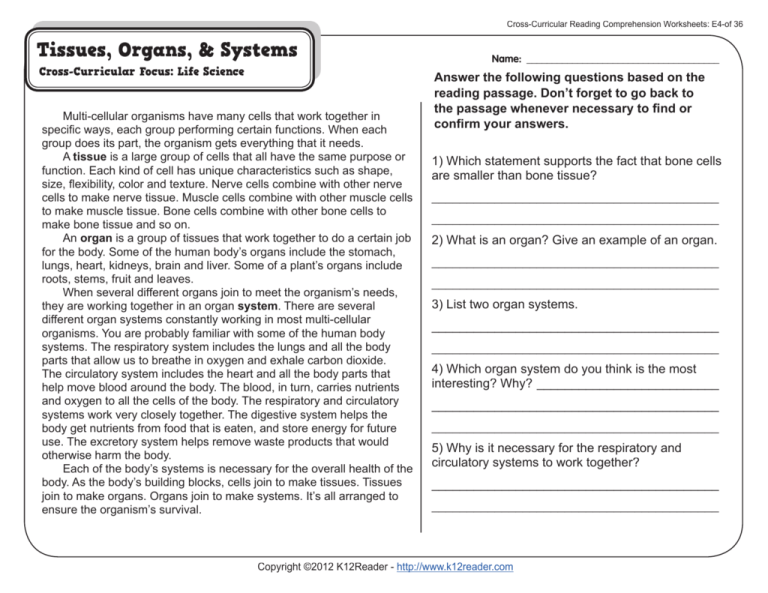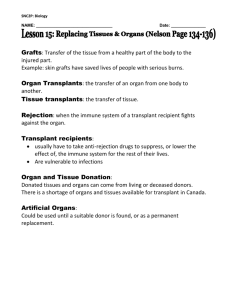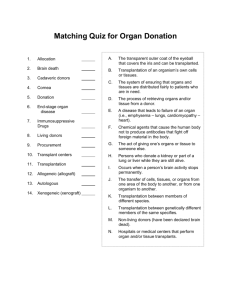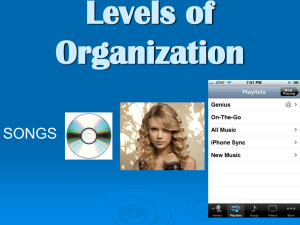Tissues, Organs, & Systems Worksheet: Life Science
advertisement

Cross-Curricular Reading Comprehension Worksheets: E4-of 36 Tissues, Organs, & Systems Cross-Curricular Focus: Life Science Multi-cellular organisms have many cells that work together in specific ways, each group performing certain functions. When each group does its part, the organism gets everything that it needs. A tissue is a large group of cells that all have the same purpose or function. Each kind of cell has unique characteristics such as shape, size, flexibility, color and texture. Nerve cells combine with other nerve cells to make nerve tissue. Muscle cells combine with other muscle cells to make muscle tissue. Bone cells combine with other bone cells to make bone tissue and so on. An organ is a group of tissues that work together to do a certain job for the body. Some of the human body’s organs include the stomach, lungs, heart, kidneys, brain and liver. Some of a plant’s organs include roots, stems, fruit and leaves. When several different organs join to meet the organism’s needs, they are working together in an organ system. There are several different organ systems constantly working in most multi-cellular organisms. You are probably familiar with some of the human body systems. The respiratory system includes the lungs and all the body parts that allow us to breathe in oxygen and exhale carbon dioxide. The circulatory system includes the heart and all the body parts that help move blood around the body. The blood, in turn, carries nutrients and oxygen to all the cells of the body. The respiratory and circulatory systems work very closely together. The digestive system helps the body get nutrients from food that is eaten, and store energy for future use. The excretory system helps remove waste products that would otherwise harm the body. Each of the body’s systems is necessary for the overall health of the body. As the body’s building blocks, cells join to make tissues. Tissues join to make organs. Organs join to make systems. It’s all arranged to ensure the organism’s survival. Name: ______________________________________ Answer the following questions based on the reading passage. Don’t forget to go back to the passage whenever necessary to find or confirm your answers. 1) Which statement supports the fact that bone cells are smaller than bone tissue? _________________________________________ _________________________________________ 2) What is an organ? Give an example of an organ. _________________________________________ _________________________________________ 3) List two organ systems. _________________________________________ _________________________________________ 4) Which organ system do you think is the most interesting? Why? __________________________ _________________________________________ _________________________________________ 5) Why is it necessary for the respiratory and circulatory systems to work together? _________________________________________ _________________________________________ Copyright ©2012 K12Reader - http://www.k12reader.com Cross-Curricular Reading Comprehension Worksheets: E4-of 36 Tissues, Organs, & Systems Cross-Curricular Focus: Life Science Multi-cellular organisms have many cells that work together in specific ways, each group performing certain functions. When each group does its part, the organism gets everything that it needs. A tissue is a large group of cells that all have the same purpose or function. Each kind of cell has unique characteristics such as shape, size, flexibility, color and texture. Nerve cells combine with other nerve cells to make nerve tissue. Muscle cells combine with other muscle cells to make muscle tissue. Bone cells combine with other bone cells to make bone tissue and so on. An organ is a group of tissues that work together to do a certain job for the body. Some of the human body’s organs include the stomach, lungs, heart, kidneys, brain and liver. Some of a plant’s organs include roots, stems, fruit and leaves. When several different organs join to meet the organism’s needs, they are working together in an organ system. There are several different organ systems constantly working in most multi-cellular organisms. You are probably familiar with some of the human body systems. The respiratory system includes the lungs and all the body parts that allow us to breathe in oxygen and exhale carbon dioxide. The circulatory system includes the heart and all the body parts that help move blood around the body. The blood, in turn, carries nutrients and oxygen to all the cells of the body. The respiratory and circulatory systems work very closely together. The digestive system helps the body get nutrients from food that is eaten, and store energy for future use. The excretory system helps remove waste products that would otherwise harm the body. Each of the body’s systems is necessary for the overall health of the body. As the body’s building blocks, cells join to make tissues. Tissues join to make organs. Organs join to make systems. It’s all arranged to ensure the organism’s survival. Key Name: ______________________________________ Answer the following questions based on the reading passage. Don’t forget to go back to the passage whenever necessary to find or confirm your answers. Actual wording of answers may vary. 1) Which statement supports the fact that bone cells are smaller than bone tissue? Bone cells combine with other bone cells to _________________________________________ make bone tissue. _________________________________________ 2) What is an organ? Give an example of an organ. An organ is a group of tissues that work _________________________________________ together to do a job for the body. Example: brain _________________________________________ 3) List two organ systems. example of correct answer: respiratory _________________________________________ and digestive _________________________________________ 4) Which organ system do you think is the most student’s choice interesting? Why? __________________________ _________________________________________ _________________________________________ 5) Why is it necessary for the respiratory and circulatory systems to work together? The respiratory system takes in oxygen which _________________________________________ the circulatory system distributes to the body. _________________________________________ Copyright ©2012 K12Reader - http://www.k12reader.com








